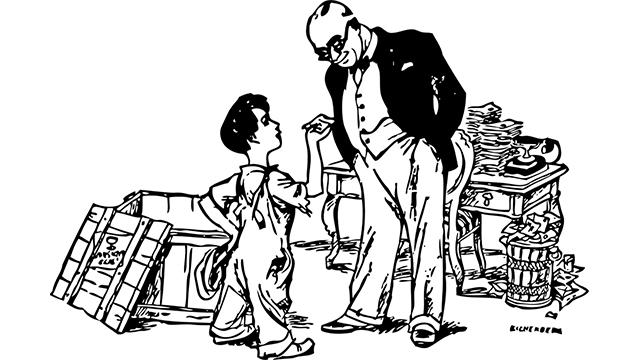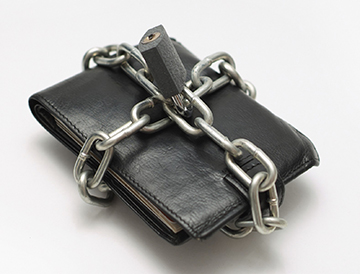
Photo: The kid and the banker white line art colouring book (1979)
When Mort Zuckerman, the New York City real-estate and media mogul, lavished $200 million on Columbia University in December to endow the Mortimer B. Zuckerman Mind Brain Behavior Institute, he did so with fanfare suitable to the occasion: the press conference was attended by two Nobel laureates, the president of the university, the mayor, and journalists from some of New York’s major media outlets. Many of the 12 other individual charitable gifts that topped $100 million in the U.S. last year were showered with similar attention: $150 million from Carl Icahn to the Mount Sinai School of Medicine, $125 million from Phil Knight to the Oregon Health & Science University, and $300 million from Paul Allen to the Allen Institute for Brain Science in Seattle, among them. If you scanned the press releases, or drove past the many university buildings, symphony halls, institutes, and stadiums named for their benefactors, or for that matter read the histories of grand giving by the Rockefellers, Carnegies, Stanfords, and Dukes, you would be forgiven for thinking that the story of charity in this country is a story of epic generosity on the part of the American rich.
It is not. One of the most surprising, and perhaps confounding, facts of charity in America is that the people who can least afford to give are the ones who donate the greatest percentage of their income. In 2011, the wealthiest Americans—those with earnings in the top 20 percent—contributed on average 1.3 percent of their income to charity. By comparison, Americans at the base of the income pyramid—those in the bottom 20 percent—donated 3.2 percent of their income. The relative generosity of lower-income Americans is accentuated by the fact that, unlike middle-class and wealthy donors, most of them cannot take advantage of the charitable tax deduction, because they do not itemize deductions on their income-tax returns.
But why? Lower-income Americans are presumably no more intrinsically generous (or “prosocial,” as the sociologists say) than anyone else. However, some experts have speculated that the wealthy may be less generous—that the personal drive to accumulate wealth may be inconsistent with the idea of communal support. Last year, Paul Piff, a psychologist at UC Berkeley, published research that correlated wealth with an increase in unethical behavior: “While having money doesn’t necessarily make anybody anything,” Piff later told New York magazine, “the rich are way more likely to prioritize their own self-interests above the interests of other people.” They are, he continued, “more likely to exhibit characteristics that we would stereotypically associate with, say, assholes.” Colorful statements aside, Piff’s research on the giving habits of different social classes—while not directly refuting the asshole theory—suggests that other, more complex factors are at work. In a series of controlled experiments, lower-income people and people who identified themselves as being on a relatively low social rung were consistently more generous with limited goods than upper-class participants were. Notably, though, when both groups were exposed to a sympathy-eliciting video on child poverty, the compassion of the wealthier group began to rise, and the groups’ willingness to help others became almost identical.If Piff’s research suggests that exposure to need drives generous behavior, could it be that the isolation of wealthy Americans from those in need is a cause of their relative stinginess? Patrick Rooney, the associate dean at the Indiana University School of Philanthropy, told me that greater exposure to and identification with the challenges of meeting basic needs may create “higher empathy” among lower-income donors. His view is supported by a recent study by The Chronicle of Philanthropy, in which researchers analyzed giving habits across all American ZIP codes. Consistent with previous studies, they found that less affluent ZIP codes gave relatively more. Around Washington, D.C., for instance, middle- and lower-income neighborhoods, such as Suitland and Capitol Heights in Prince George’s County, Maryland, gave proportionally more than the tony neighborhoods of Bethesda, Maryland, and McLean, Virginia. But the researchers also found something else: differences in behavior among wealthy households, depending on the type of neighborhood they lived in. Wealthy people who lived in homogeneously affluent areas—areas where more than 40 percent of households earned at least $200,000 a year—were less generous than comparably wealthy people who lived in more socioeconomically diverse surroundings. It seems that insulation from people in need may dampen the charitable impulse.
Wealth affects not only how much money is given but to whom it is given. The poor tend to give to religious organizations and social-service charities, while the wealthy prefer to support colleges and universities, arts organizations, and museums. Of the 50 largest individual gifts to public charities in 2012, 34 went to educational institutions, the vast majority of them colleges and universities, like Harvard, Columbia, and Berkeley, that cater to the nation’s and the world’s elite. Museums and arts organizations such as the Metropolitan Museum of Art received nine of these major gifts, with the remaining donations spread among medical facilities and fashionable charities like the Central Park Conservancy. Not a single one of them went to a social-service organization or to a charity that principally serves the poor and the dispossessed. More gifts in this group went to elite prep schools (one, to the Hackley School in Tarrytown, New York) than to any of our nation’s largest social-service organizations, including United Way, the Salvation Army, and Feeding America (which got, among them, zero).
Underlying our charity system—and our tax code—is the premise that individuals will make better decisions regarding social investments than will our representative government. Other developed countries have a very different arrangement, with significantly higher individual tax rates and stronger social safety nets, and significantly lower charitable-contribution rates. We have always made a virtue of individual philanthropy, and Americans tend to see our large, independent charitable sector as crucial to our country’s public spirit. There is much to admire in our approach to charity, such as the social capital that is built by individual participation and volunteerism. But our charity system is also fundamentally regressive, and works in favor of the institutions of the elite. The pity is, most people still likely believe that, as Michael Bloomberg once said, “there’s a connection between being generous and being successful.” There is a connection, but probably not the one we have supposed.
3 WAYS TO SHOW YOUR SUPPORT
- Log in to post comments


















